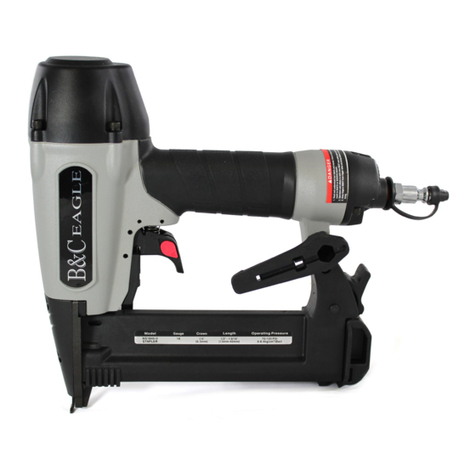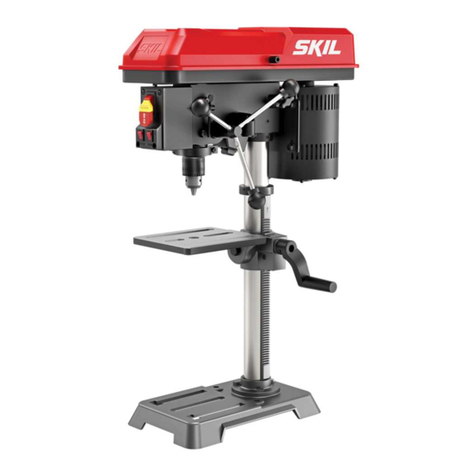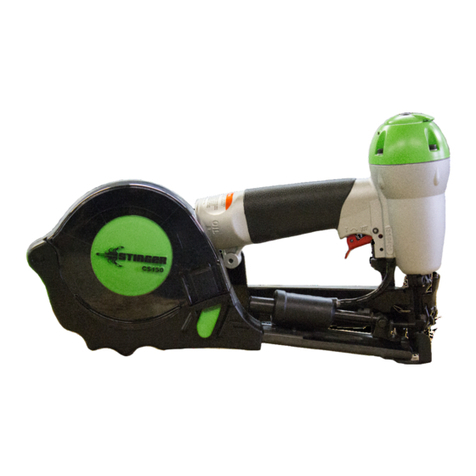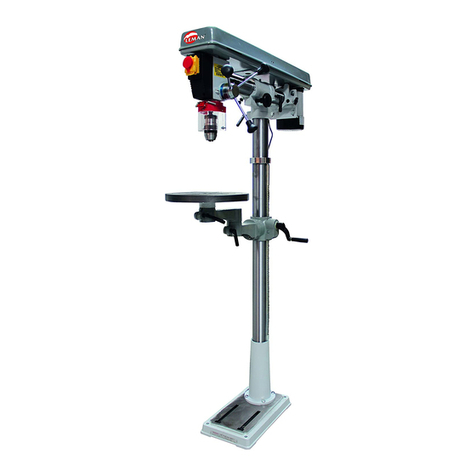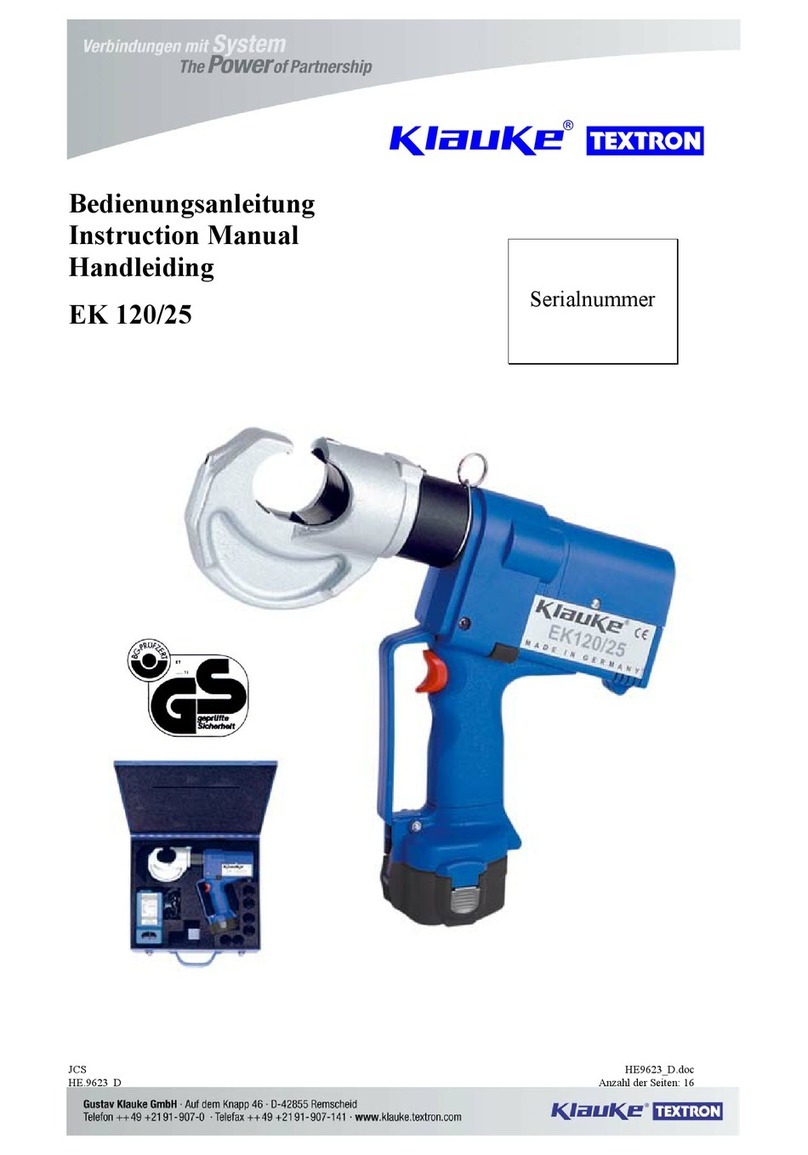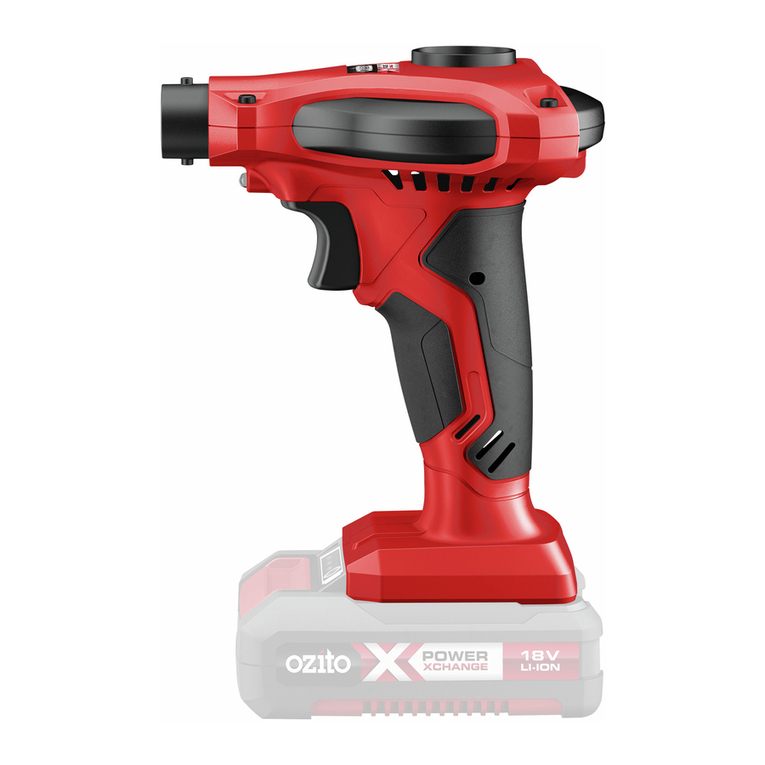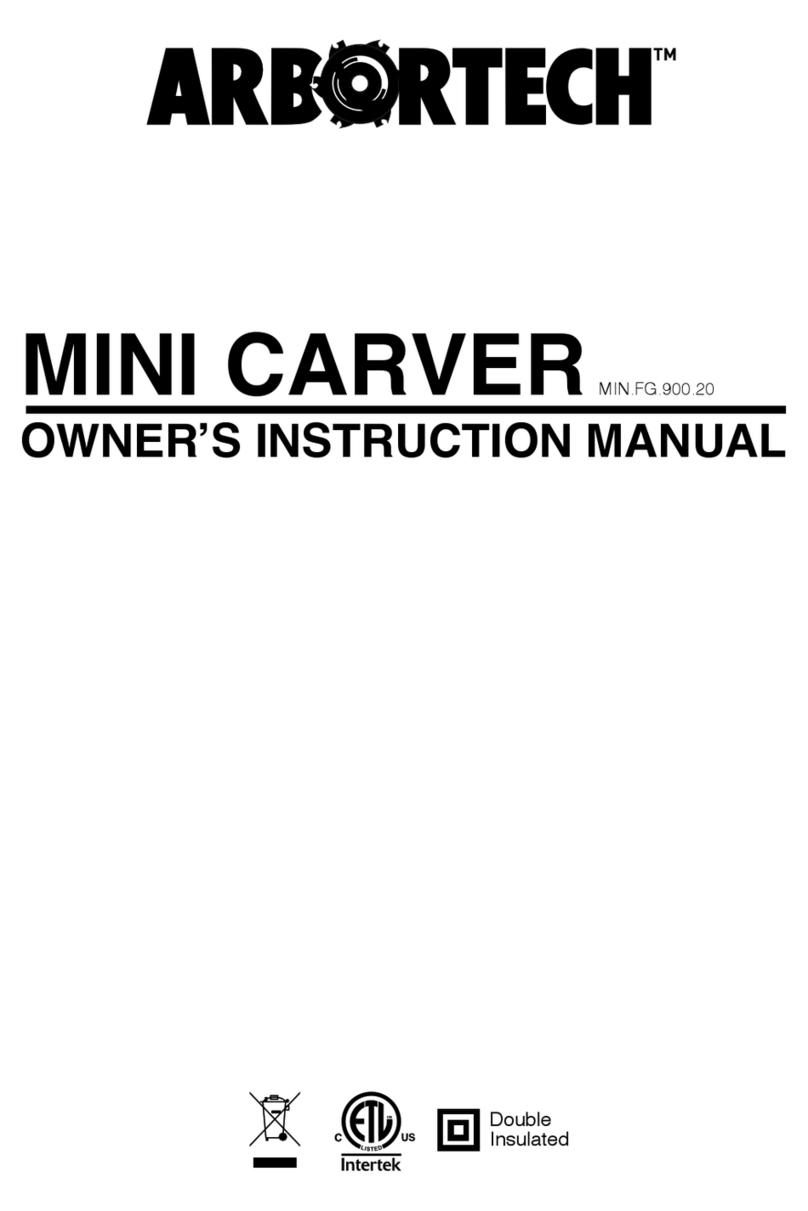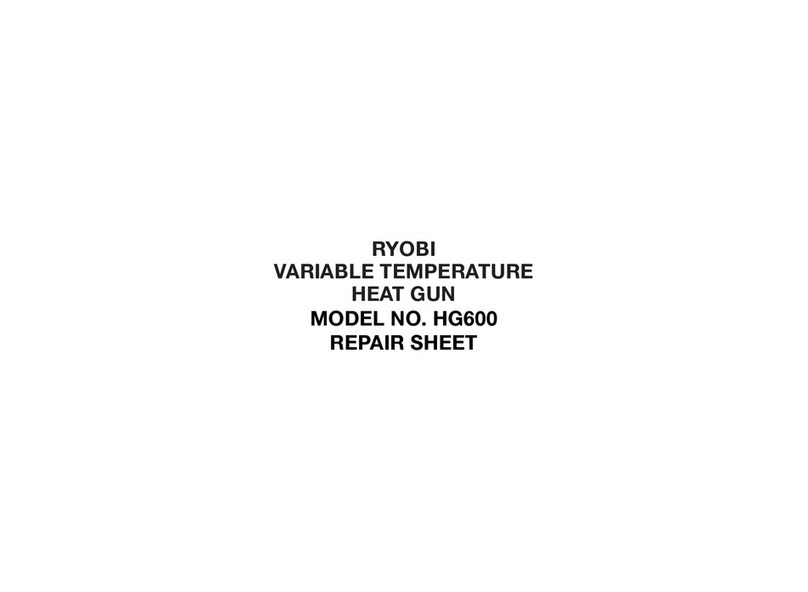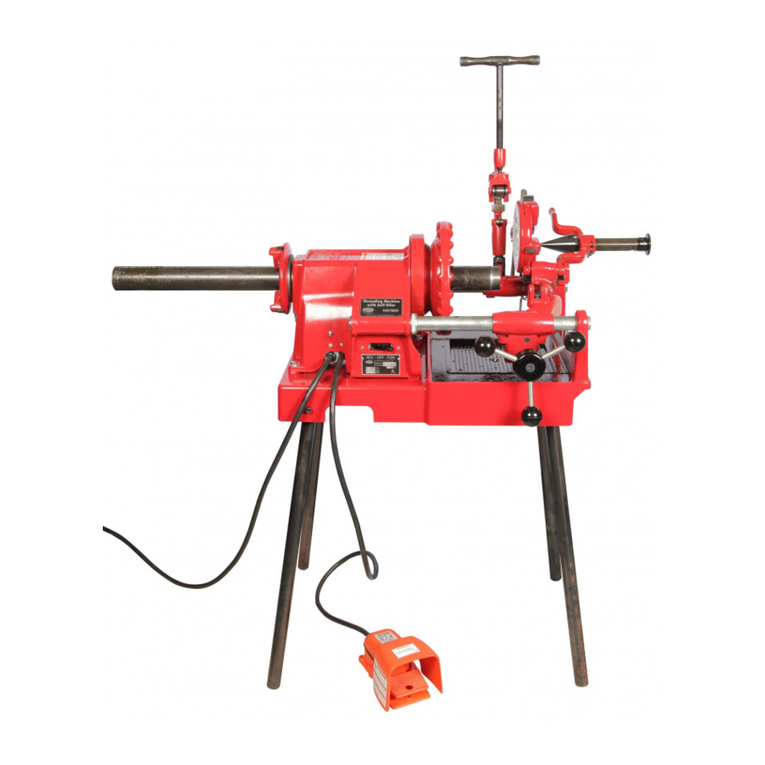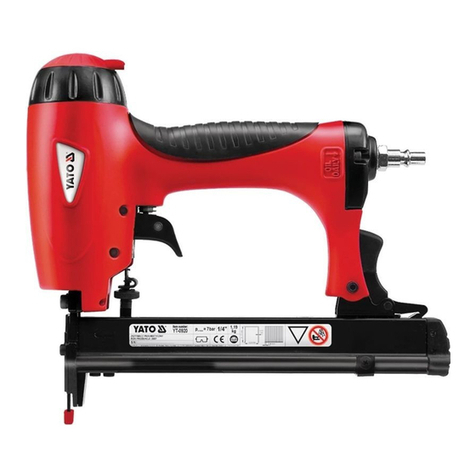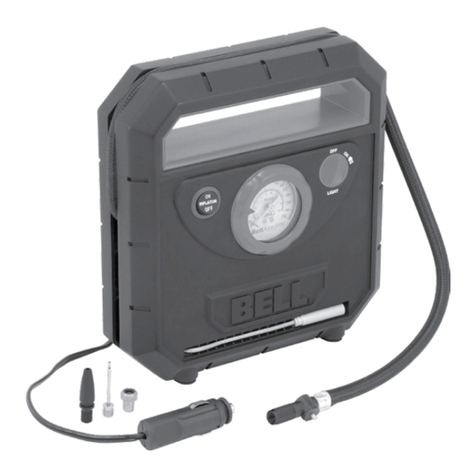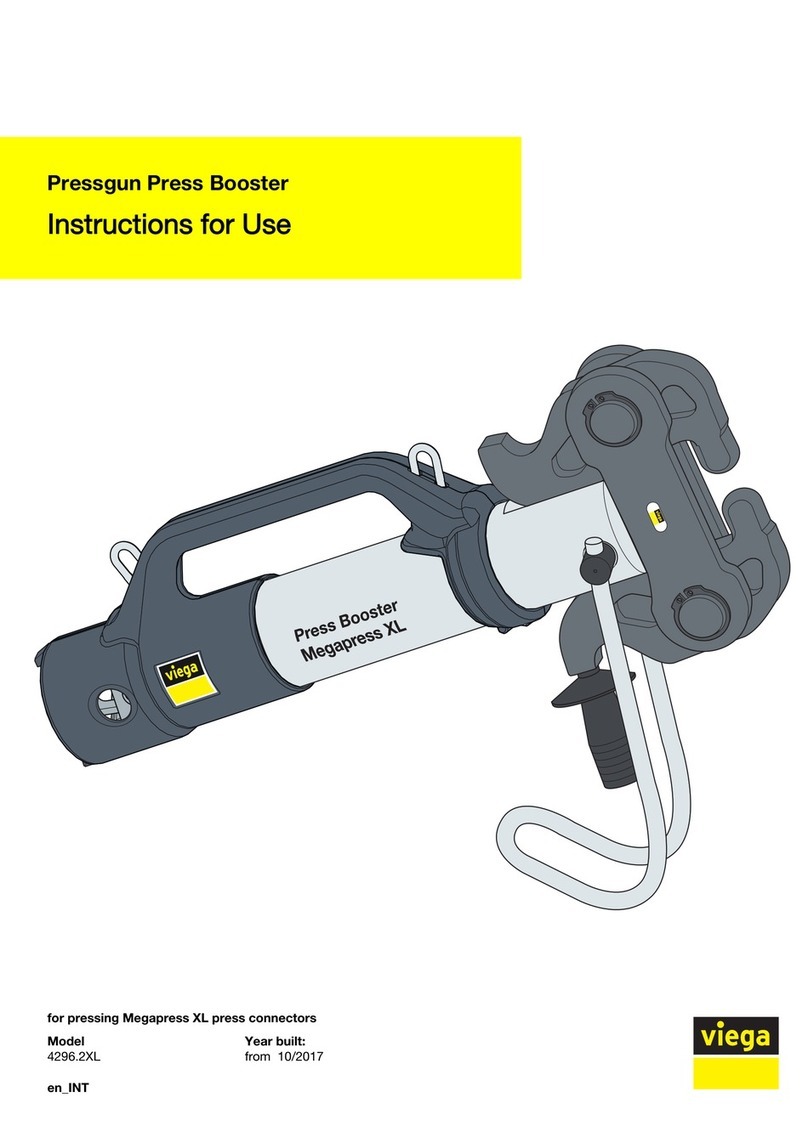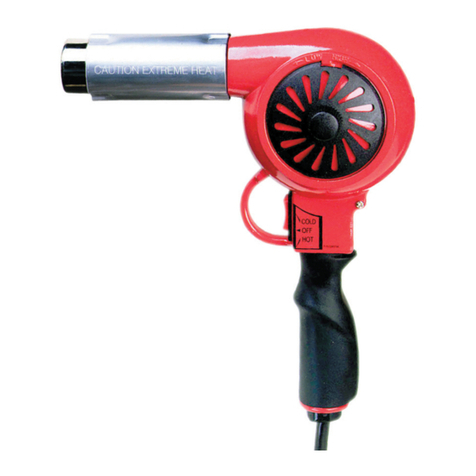Toolshop 241-9970 User manual

3" CUT-OFF TOOL
241-9970
Owner’s Manual
PRODUCT SPECIFICATIONS
Rating: 120V, 60Hz, AC
Amperes: 3.5 AMP
Speed: 24,000 RPM (no load)
Arbor: 3/8"
Cut-off wheel: 3" Diameter x 1/16" thick
Weight: 3 lb
Need Assistance?
Call us on our toll free customer support line:
1-866-349-8665
•Technical questions
•Replacement parts
•Parts missing from package

2
Product specifications ………….………………………………………………………………... 1
Table of contents …………………………………………………………………….................. 2
General safety warnings ………………………………………………………………………… 3–4
Eye, ear & lung protection ………………………………………………………………………. 3–4
Electrical safety …………………………………………………………………………………... 4
Power tool safety …………………………………………………………………….................. 5–6
General safety rules ……………………………………………………………………………... 5
Work area ………………………………………………………………….……………………... 5
Electrical safety …………………………………………………………………………………... 5
Personal safety …………………………………………………………………………………... 5
Power tool use and care.………………………………………………………………………… 6
Service ……………………………………………………………………………………………. 6
Specific safety rules ……………………………………………………………………………... 6–9
Kickback and related warnings …………………………………………………………………. 7–8
Safety warnings for cutting-off operations …………………………………………………….. 8
Additional safety instructions for cutting-off operations ……………………………………… 8–9
Extension cord safety ………………………………………………………….………………… 9
Symbols …………………………………………………………………………………………… 10
Know your cut-off tool ………………………….................................................................... 11
Assembly and operating ………………………………………………………………………… 12–14
Installing the guard ………………………………………………………………………………. 12
Installing the cutting disc ………………………………………………………………………... 12–13
ON/OFF switch …………………………………………………………………………………… 13
General cutting …………………………………………………………………………………… 14
Maintenance ……………………………………………………………………………………… 14
Exploded view ………………………………………………………………………................... 15
Parts listing ……………………………………………………………………………………….. 16
Warranty ……………………………………………………………………….…………………. 17
TABLE OF CONTENTS

3
EYE, EAR & LUNG PROTECTION
SAVE THESE INSTRUCTIONS FOR REFERENCE
GENERAL SAFETY WARNINGS
Th
is instruction manual includes the following:
•General Safety Rules
•Specific Safety Rules and Symbols
•Functional Description
•Assembly
•Operation
•Maintenance
•Accessories
WARNING: Before using this tool or any of its accessories, read this
manual and follow all Safety Rules and Operating Instructions. The important
precautions, safeguards and instructions appearing in this manual are not
meant to cover all possible situations. It must be understood that common
sense and caution are factors which cannot be built into the product.
!
!
ALWAYS WEAR EYE PROTECTION THAT CONFORMS WITH CSA
REQUIREMENTS or ANSI SAFETY STANDARD Z87.1
FLYING DEBRIS can cause permanent eye damage. Prescription
eyeglasses ARE NOT a replacement for proper eye protection.
WARNING: Non-compliant eyewear can cause serious injury if
broken during the operation of a power tool.
WARNING: Use hearing protection, particularly during extended
periods of operation of the tool, or if the operation is noisy.
!
SAVE THESE INSTRUCTIONS FOR REFERENCE

4
ELECTRICAL SAFETY
GENERAL SAFETY WARNINGS
WEAR A DUST MASK THAT IS DESIGNED TO BE USED WHEN
OPERATING A POWER TOOL IN A DUSTY ENVIRONMENT.
WARNING: Dust that is created by power sanding, sawing, grinding,
drilling, and other construction activities may contain chemicals that are
known to cause cancer, birth defects, or other genetic abnormalities. These
chemicals include:
Lead from lead-based paints
Crystalline silica from bricks, cement, and other masonry products
Arsenic and chromium from chemically treated lumber
The level of risk from exposure to these chemicals varies, according to how
often this type of work is performed. In order to reduce exposure to these
chemicals, work in a well-ventilated area, and use approved safety
equipment, such as a dust mask that is specifically designed to filter out
microscopic particles.
!
WARNING: To avoid electrical hazards, fire hazards or damage to the
tool, use proper circuit protection.
This tool is wired at the factory for 120 V AC operation. It must be
connected to a 120 V AC, 15 A circuit that is protected by a time-delayed
fuse or circuit breaker. To avoid shock or fire, replace power cord
immediately if it is worn, cut or damaged in any way.
SAVE THESE INSTRUCTIONS FOR REFERENCE

5
WARNING:
Read all safety warnings
and instructions. Failure to follow the warnings
and instructions may result in electric shock, fire
and/or serious injury.
Save all warnings and instructions for future
reference.
Work area safety
Keep work area clean and well lit. Cluttered or
dark areas invite accidents.
Do not operate power tools in explosive
atmospheres, such as in the presence of
flammable liquids, gases or dust. Power tools
create sparks which may ignite the dust or
fumes.
Keep children and bystanders away while
operating a power tool. Distractions can cause
you to lose control.
Electrical safety
Power tool plugs must match the outlet.
Never modify the plug in any way. Do not
use any adapter plugs with earthed
(grounded) power tools. Unmodified plugs and
matching outlets will reduce risk of electric
shock.
Avoid body contact with earthed or
grounded surfaces such as pipes, radiators,
ranges and refrigerators. There is an
increased risk of electric shock if your body is
earthed or grounded.
Do not expose power tools to rain or wet
conditions. Water entering a power tool will
increase the risk of electric shock.
Do not abuse the cord. Never use the cord
for carrying, pulling or unplugging the power
tool. Keep cord away from heat, oil, sharp
edges or moving parts. Damaged or
entangled cords increase the risk of electric
shock.
When operating a power tool outdoors, use
an extension cord suitable for outdoor use.
Use of a cord suitable for outdoor use reduces
the risk of electric shock.
If operating a power tool in a damp location
is unavoidable, use a residual current device
(RCD) protected supply. Use of a ground fault
circuit interrupter (GFCI) reduces the risk of
electric shock.
Personal safety
Stay alert, watch what you are doing and use
common sense when operating a power tool.
Do not use a power tool while you are tired
or under the influence of drugs, alcohol or
medication. A moment of inattention while
operating power tools may result in serious
personal injury.
Use personal protective equipment. Always
wear eye protection. Protective equipment
such as dust mask, non-skid safety shoes, hard
hat, or hearing protection used for appropriate
conditions will reduce personal injuries.
Prevent unintentional starting. Ensure the
switch is in the off-position before
connecting to power source and/or battery
pack, picking up or carrying the tool.
Carrying power tools with your finger on the
switch or energizing power tools that have the
switch on invites accidents.
Remove any adjusting key or wrench before
turning the power tool on. A wrench or a key
left attached to a rotating part of the power tool
may result in personal injury.
Do not overreach. Keep proper footing and
balance at all times. This enables better
control of the power tool in unexpected
situations.
Dress properly. Do not wear loose clothing
or jewelry. Keep your hair, clothing and
gloves away from moving parts. Loose
clothes, jewelry or long hair can be caught in
moving parts.
If devices are provided for the connection of
dust extraction and collection facilities,
ensure these are connected and properly
used. Use of dust collection can reduce dust-
related hazards.
POWER TOOL SAFETY
!

6
Power tool use and care
Do not force the power tool. Use the correct
power tool for your application. The correct
power tool will do the job better and safer at the
rate for which it was designed.
Do not use the power tool if the switch does
not turn it on and off. Any power tool that
cannot be controlled with the switch is
dangerous and must be repaired.
Disconnect the plug from the power source
and/or the battery pack from the power tool
before making any adjustments, changing
accessories, or storing power tools. Such
preventive safety measures reduce the risk of
starting the power tool accidentally.
Store idle power tools out of the reach of
children and do not allow persons unfamiliar
with the power tool or these instructions to
operate the power tool. Power tools are
dangerous in the hands of untrained users.
Maintain power tools. Check for
misalignment or binding of moving parts,
breakage of parts and any other condition
that may affect the power tool’s operation. If
damaged, have the power tool repaired
before use. Many accidents are caused by
poorly maintained power tools.
Keep cutting tools sharp and clean. Properly
maintained cutting tools with sharp cutting
edges are less likely to bind and are easier to
control.
Use the power tool, accessories and tool bits
etc. in accordance with these instructions,
taking into account the working conditions
and the work to be performed. Use of the
power tool for operations different from those
intended could result in a hazardous situation.
Service
Have your power tool serviced by a qualified
repair person using only identical
replacement parts. This will ensure that the
safety of the power tool is maintained.
WARNING
: This power tool is intended
to function as a cut-off tool. Read all safety
warnings, instructions, illustrations and
specifications provided with this power tool.
Failure to follow all instructions listed below may
result in electric shock, fire and/or serious injury.
Operations such as grinding, sanding, wire
brushing or polishing are not
recommended to be performed with this
power tool. Operations for which the power tool
was not designed may create a hazard and
cause personal injury.
Always wear eye protection. Any
power tool can throw foreign
objects into your eyes and cause
permanent eye damage. ALWAYS
wear safety goggles (not glasses) that comply
with ANSI safety standard Z87.1. Everyday
glasses have only impact resistant lenses. They
ARE NOT safety glasses.
WARNING:
Glasses or goggles not in
compliance with ANSI Z87.1 could cause
serious injury when they break.
WARNING:
Always use hearing
protection when cutting, particularly during
extended periods of operation.
WARNING:
Always unplug the tool from
the power source before changing the cut-off
disk and when making any adjustments.
Do not use accessories which are not
specifically designed and recommended by
the tool manufacturer. Just because the
accessory can be attached to your power tool, it
does not assure safe operation.
The rated speed of the accessory must be at
least equal to the maximum speed
marked on the power tool. Accessories
running faster than their RATED SPEED can
break and fly apart.
SAVE THESE INSTRUCTIONS FOR REFERENCE
POWER TOOL SAFETY
!
!
!
!
SPECIFIC SAFETY
RULES

7
The outside diameter and the thickness of
your accessory must be within the capacity
rating of your power tool. Incorrectly sized
accessories cannot be adequately guarded or
controlled.
The arbor size of wheels, flanges, backing
pads or any other accessory must properly
fit the spindle of the power tool. Accessories
with arbor holes that do not match the mounting
hardware of the power tool will run out of
balance, vibrate excessively and may cause
loss of control.
Do not use a damaged accessory. Before
each use inspect the accessory such as
abrasive wheels for chips and cracks,
backing pad for cracks, tear or excess wear,
wire brush for loose or cracked wires. If
power tool or accessory is dropped, inspect
for damage or install an undamaged
accessory. After inspecting and installing an
accessory, position yourself and bystanders
away from the plane of the rotating
accessory and run the power tool at
maximum no-load speed for one minute.
Damaged accessories will normally break apart
during this test time.
Wear personal protective equipment.
Depending on application, use face shield,
safety goggles or safety glasses. As
appropriate, wear dust mask, hearing
protectors, gloves and workshop apron
capable of stopping small abrasive or
workpiece fragments. The eye protection
must be capable of stopping flying debris
generated by various operations. The eye
protection must be capable of stopping flying
debris generated by various operations. The
dust mask or respirator must be capable of
filtrating particles generated by your operation.
Prolonged exposure to high intensity noise may
cause hearing loss.
Keep bystanders a safe distance away from
work area. Anyone entering the work area
must wear personal protective equipment.
Fragments of workpiece or of a broken
accessory may fly away and cause injury
beyond immediate area of operation.
Hold power tool by insulated gripping
surfaces only, when performing an operation
where the cutting accessory may contact
hidden wiring or its own cord. Cutting
accessory contacting a ″live″wire may make
exposed metal parts of the power tool ″live″and
shock the operator.
Position the cord clear of the spinning
accessory. If you lose control, the cord may be
cut or snagged and your hand or arm may be
pulled into the spinning accessory.
Never lay the power tool down until the
accessory has come to a complete stop. The
spinning accessory may grab the surface and
pull the power tool out of your control.
Do not run the power tool while carrying it at
your side. Accidental contact with the spinning
accessory could snag your clothing, pulling the
accessory into your body.
Regularly clean the power tool’s air vents.
The motor’s fan will draw the dust inside the
housing and excessive accumulation of
powdered metal may cause electrical hazards.
Do not operate the power tool near
flammable materials. Sparks could ignite these
materials.
Do not use accessories that require liquid
coolants. Using water or other liquid coolants
may result in electrocution or shock.
Kickback and related warnings
Kickback is a sudden reaction to a pinched or
snagged rotating cutting disc. Pinching or
snagging causes rapid stalling of the rotating
disc which in turn causes the uncontrolled
power tool to be forced in the direction opposite
of the accessory’s rotation at the point of the
binding.
SPECIFIC SAFETY RULES

8
Kickback and Related Warnings – cont’d
For example, if the cutting disc is snagged or
pinched by the workpiece, the edge of the wheel
that is entering into the pinch point can dig into
the surface of the material causing the wheel to
climb out or kick out. The wheel may either jump
toward or away from the operator, depending on
direction of the wheel’s movement at the point of
pinching. Cutting discs may also break under
these conditions.
Kickback is the result of power tool misuse
and/or incorrect operating procedures or
conditions and can be avoided by taking proper
precautions as given below.
Maintain a firm grip on the power tool and
position your body and arm to allow you to
resist kickback forces. Always use auxiliary
handle, if provided, for maximum control
over kickback or torque reaction during
start-up. The operator can control torque
reactions or kickback forces, if proper
precautions are taken.
Never place your hand near the rotating
accessory. Accessory may kickback over your
hand.
Do not position your body in the area where
power tool will move if kickback occurs.
Kickback will propel the tool in direction opposite
to the wheel’s movement at the point of
snagging.
Use special care when working corners,
sharp edges etc. Avoid bouncing and
snagging the accessory. Corners, sharp
edges or bouncing have a tendency to snag the
rotating accessory and cause loss of control or
kickback.
Do not attach a saw chain woodcarving
blade or toothed saw blade. Such blades
create frequent kickback and loss of control.
Safety warnings for cutting-off operations
Use only wheel types that are recommended
for your power tool and the specific guard
designed for the selected wheel. Wheels for
which the power tool was not designed cannot
be adequately guarded and are unsafe.
The guard must be securely attached to the
power tool and positioned for maximum
safety, so the least amount of wheel is
exposed towards the operator. The guard
helps to protect operator from broken wheel
fragments and accidental contact with wheel.
Wheels must be used only for recommended
applications. For example: do not grind
with the side of cut-off wheel. Abrasive cut-off
wheels are intended for peripheral grinding,
side forces applied to these wheels may cause
them to shatter.
Always use undamaged wheel flanges that
are of correct size and shape for your
selected wheel. Proper wheel flanges support
the wheel thus reducing the possibility of wheel
breakage. Flanges for cut-off wheels may be
different from grinding wheel flanges.
Do not use worn down wheels from larger
power tools. Wheel intended for larger power
tool is not suitable for the higher speed of a
smaller tool and may burst.
Additional safety instructions for cutting-off
operations
Do not ″jam″the cut-off wheel or apply
excessive pressure. Do not attempt to make
an excessive depth of cut. Overstressing the
wheel increases the loading and susceptibility to
twisting or binding of the wheel in the cut and
the possibility of kickback or wheel breakage.
Do not position your body in line with and
behind the rotating wheel. When the wheel,
at the point of operation, is moving away from
your body, the possible kickback may propel the
spinning wheel and the power tool directly at
you.
When cut-off disc is binding or when
interrupting a cut for any reason, switch off
the power tool and hold the power tool
motionless until the wheel comes to a
complete stop. Never attempt to remove the
cut-off wheel from the cut while the wheel is
in motion otherwise kickback may occur.
Investigate and take corrective action to
eliminate the cause of wheel binding.
SPECIFIC SAFETY RULES

9
Additional safety instructions for cutting-off
operations – cont’d
Do not restart the cutting operation in the
workpiece. Let the wheel reach full speed
and carefully reenter the cut. The cut-off disc
may bind, walk up or kickback if the power tool
is restarted in the workpiece.
Support panels or any oversized workpiece
to minimize the risk of cut-off disc pinching
and kickback. Large workpieces tend to sag
under their own weight. Supports must be
placed under the workpiece near the line of cut
and near the edge of the workpiece on both
sides of the cut-off disc.
Use extra caution when making a ″pocket
cut″into existing walls or other blind areas.
The protruding wheel may cut gas or water
pipes, electrical wiring or objects that can cause
kickback.
WARNING:
Keep the extension cord
clear of the working area. Position the cord so
it will not get caught on the workpiece, tools or
any other obstructions while you are working
with the power tool.
Make sure any extension cord used with this
tool is in good condition. When using an
extension cord, be sure to use one of heavy
enough gauge to carry the current the tool will
draw. An undersized cord will cause a drop in
line voltage resulting in loss of power and
overheating.
The table at right shows the correct size to use
according to cord length and nameplate ampere
rating. If in doubt, use the next heavier gauge.
The smaller the gauge number the heavier the
cord.
Be sure your extension cord is properly wired
and in good condition. Always replace a
damaged extension cord or have it repaired by a
qualified electrician before using it. Protect your
extension cord from sharp objects, excessive
heat and damp or wet areas.
Use a separate electrical circuit for your power
tools. This circuit must not be less than 14
gauge wire and should be protected with either
a 15 AMP time delayed fuse or circuit breaker.
Before connecting the power tool to the power
source, make sure the switch is in the OFF
position and the power source is the same as
indicated on the nameplate. Running at lower
voltage will damage the motor.
WARNING:
Repair or replace damaged
or worn extension cords immediately.
Select the appropriate extension cord gauge
and length using the chart below.
When operating a power tool outdoors, use
an outdoor extension cord marked "W-A" or
"W". These cords are rated for outdoor use and
reduce the risk of electric shock.
WARNING:
Keep the extension cord
clear of the working area. Position the cord
so it will not get caught on the workpiece,
tools or any other obstructions while you are
working with the power tool.
MINIMUM GAUGE (AWG)
EXTENSION CORDS (120V use only)
Amperage
rating
Total length
More
than
Not
more
than
25'
(7.5 m)
50'
(15 m)
100'
(30 m)
150'
(45 m)
0 6 18 16 16 14
6 10 18 16 14 12
10 12 16 16 14 12
12 16 14 12 Not Applicable
EXTENSION CORD
!
!
!
SPECIFIC SAFETY
RULES
EXTENSION CORD

10
This symbol designates that this tool is
listed with U.S. requirements by
ETL Testing Laboratories, Inc.
Conforms to UL Std. 60745-1.
3042597
JD3313U
V
Volts
A
Amperes
Hz
Hertz
W
Watts
kW
Kilowatts
Microfarads
L
Liters
kg
Kilograms
H
Hours
N/cm
2
Newtons per square
centimeter
Pa
Pascals
OPM
Oscillations per minute
Min
Minutes
S
Seconds
or a.c.
Alternating current
Three-phase alternating
current
Three-phase alternating
current with neutral
Direct current
No load speed
Alternating or direct
current
Class II construction
Splash-proof
construction
Watertight construction
Protective grounding at
grounding terminal,
Class I tools
Revolutions or
reciprocations per
minute
Diameter
Off position
Arrow
Warning symbol
Wear your safety
glasses
SYMBOLS
WARNING:
Some of the following symbols may appear on the cut-off tool. Study
these symbols and learn their meaning. Proper interpretation of these symbols will
allow for more efficient and safer operation of this tool.
!

11
KNOW YOUR CUT
-
OFF TOOL
Guard
ON/OFF
switch
Hex
screw
Motor
vents
Flange
washer
Guard locking
lever
Cut-off
disc
Motor
vents
14 mm
Spindle wrench
#6140010021 3" Cut-off disc
#6080020001
5 mm
Hex key
#6140020001

12
INSTALLING THE GUARD
WARNING:
The guard must be installed
and properly positioned before installing a
cutting disc or operating the tool.
1. Pull the guard locking lever (1) outward
from its locked position.
2. Slide the guard mounting clamp (2) over
the guard mount (3) on the tool.
NOTE: Place the detent (4) so it will slide
over the slot (5) in the guard mount.
3. When the guard clamp is fully slid onto the
guard mount, rotate the guard 180°so it is
positioned at the top of the tool (Fig. 2).
4. Press the guard clamping lever firmly
inward toward the clamp to lock the clamp
onto the tool.
INSTALLING THE CUTTING DISC
WARNING:
Remove the plug from the
power source before installing or removing a
cutting disc.
WARNING:
Make sure the replacement
cutting disc is rated for at least 24,000 RPM and
is in good condition.
1. Place the spindle wrench (1) on the flat
portion of the spindle (Fig. 3).
2. Insert the 5 mm hex key (2) into the hex
head screw (3).
3. While holding the spindle wrench, turn the
hex screw counter clockwise to remove
both the hex head screw and the flange
washer (4).
4. Slide the cutting disc (5) into the guard (6)
and place it over the spindle shoulder (7)
so it rests flat against the large spindle
flange (8).
5. Reinstall and tighten the flange washer and
hex screw.
NOTE: Make sure the cutting disc is on the
spindle shoulder before tightening the hex
head screw.
WARNING:
Once the hex screw is firmly
tightened, hold the tool so the guard is
between you and the cutting disc and turn
the tool ON. If the cutting disc wobbles or
the tool vibrates, turn the tool OFF
immediately and investigate and correct the
cause.
ASSEMBLY AND OPERATING
NOTE:
The drawings in the assembly and
operating section of this manual may
differ slightly from the tool you purchased.
!
!
!
!
Fig. 1
Fig. 2

13
INSTALLING THE CUTTING DISC – cont’d
ON/OFF SWITCH
WARNING:
Before starting the tool, make
sure the cutting disc is in good condition, is
properly installed and not in contact with any
surface.
This tool has a combination lock-out and
ON/OFF switch to avoid unintentional starting of
the tool. To turn the switch ON:
1. Grasp the tool with two hands.
2. Press downward on the rear of the
ON/OFF switch with your thumb (Fig. 4).
3. While pressing downward on the rear of
the ON/OFF switch, slide the switch
forward to start the tool.
NOTE: The ON/OFF switch will click into
the lock-on position when the switch button
is pushed fully forward. The tool will
continue to operate until the switch is
turned OFF.
4. To turn the tool OFF, press downward in
the rear of the switch button.
Fig. 3
ASSEMBLY AND OPERATING
!
Fig. 4
For safety reasons, the operator must
read the sections of this Owner’s Manual
entitled "GENERAL SAFETY
WARNINGS", "POWER TOOL SAFETY",
"SPECIFIC SAFETY RULES",
"EXTENSION CORD SAFETY" and
"SYMBOLS" before using this cut-off
tool.
Verify the following every time the cut-off
tool is used:
1. The cut-off disc is in good condition
and properly installed on the tool.
2. The guard is properly positioned on
the tool and in the correct position
to protect the operator.
3. The workpiece is firmly clamped in a
vise or to a stable work surface.
4. Safety glasses and appropriate
safety gear are being worn.
5. No flammable liquids or materials
are in the area.
6. All bystanders are well clear of the
area.
Failure to observe these safety rules will
significantly increase the risk of injury.
WARNING
!

14
GENERAL CUTTING
DANGER:
Always clamp the workpiece
firmly into a vise or to a stable work surface.
Never hold the workpiece with one hand and
the tool with the other hand. Severe injury
may result.
WARNING:
Always wear appropriate
eye, ear and breathing protection and
protective clothing when operating the cut-
off tool.
1. Mark the workpiece where the cut is to be
made.
2. Firmly clamp the workpiece in a vise or to a
stable work surface.
3. Grasp the tool with both hands, turn the
tool ON and wait until it reaches full speed.
4. Carefully place the edge of the cutting disc
onto the workpiece surface.
5. While cutting, keep the tool moving over
the workpiece, while maintaining a steady
pressure on the cut-off disc.
NOTE: Do not force the tool by applying
too much pressure. The tool will slow down
and will not cut properly. It will also
damage the motor.
6. When the cut is completed, release the
ON/OFF switch and allow the cut-off disc to
stop before putting the tool down.
GENERAL
WARNING:
When servicing, use only
identical replacement parts. The use of any
other part may create a hazard or cause
product damage.
DO NOT use solvents when cleaning plastic
parts. Plastics are susceptible to damage from
various types of commercial solvents and may
be damaged by their use. Use a clean cloth to
remove dirt, dust, oil, grease etc.
WARNING:
Do not allow brake fluids,
gasoline, petroleum-based products,
penetrating oils, etc. to come into contact
with plastic parts. They contain chemicals
that can damage, weaken or destroy plastic.
DO NOT abuse power tools. Abusive practices
can damage the tool and the workpiece.
WARNING:
DO NOT attempt to modify
tools or create accessories. Any such
alteration or modification is misuse and
could result in a hazardous condition leading
to possible serious injury. It will also void
the warranty.
It has been found that electric tools are
subjected to accelerated wear and possible
premature failure when they are used for cutting
and grinding metals. The grindings from these
materials are highly abrasive to electric tool
parts such as bearings, brushes, commutators,
etc. Consequently, it is not recommended that
this tool be used for extended work on any
metals. During any use on these materials it is
extremely important that the tool is cleaned
frequently by blowing it out with an air jet.
WARNING:
Always wear safety goggles
or safety glasses with side shields during all
cut-off and grinding operations. It is critical
that you also wear safety goggles or safety
glasses with side shields and a dust mask
while blowing dust out of the cut-off tool
with an air jet. Failure to take these safety
precautions could result in permanent eye or
lung damage.
LUBRICATION
All of the bearings in this tool are lubricated with
a sufficient amount of high-grade lubricant for
the life of the unit under normal conditions.
Therefore, no further lubrication is required.
ASSEMBLY AND
OPERATING
MAINTENANCE
!
!
!
!
!
MAINTENANCE
!

15
EXPLODED VIEW

16
WARNING:
When servicing, use only original equipment replacement parts. The use of any
other parts may create a safety hazard or cause damage to the cut-off tool.
Any attempt to repair or replace electrical parts on this cut-off tool may create a safety hazard unless
repairs are performed by a qualified technician. For more information, call the Toll-free Helpline, at
1-866-349-8665.
Always order by PART NUMBER, not by key number.
Key #
Part #
Part Name
Quantity
1 3011230002 Housing 1
2 2050080170 Switch button spring 1
3 3120010080 Switch button 1
4 2050060202 Shank spring 1
5 3120110060 Switch shank 1
6 1062020001 Switch 1
7 4030010094 Tapping screw ST3.9X10 2
8 3150020001 Cord clamp 1
9 3160010061 Back cover 6
10 1230030020 Brush assembly 2
11 1230010132 Carbon brush 2
12 4030010094 Tapping screw ST3.9X10 2
13 3140010003 Cord guard 1
14 1190030033 Cord 1
15 4030010099 Tapping screw ST3.9X14 4
16 2020050064 Aluminum cover 1
17 4010010014 Bearing 629-2RS 1
18 2030160001 Bearing retainer 1
19 4020020021 Recessed screw ST3.9X8 2
20 1010230002 Rotor 1
21 4030010034 Insulating baffle 1
22 4010010036 Bearing 608ZZ 1
23 3150050081 Fan baffle 1
24 3150050081 Stator 1
25 1160040012 Locking lever 1
26 Locking lever cover 1
27 4090040014 Rivet 4X10 1
28 2040140042 Locking bolt 1
29 2030020220 Square washer 1
30 1270030034 Grinding wheel guard 1
31 4040030003 Washer 5mm 1
32 4060010002 Nut 5mm 1
33 4020080019 Hex socket head cap screw M6X13 1
34 2040210040 Grinding wheel flat washer 1
35 6080020001 Grinding wheel 1
36 2040290075 Shaft 1
37 4100010003 Φ28 circlip 1
38 2030020289 Washer 2
39 3190010042 Wool washer 1
40 6140020001 5 mm Hex key 1
41 6140010021 14 mm Spindle wrench 1
PARTS LIST
!

17
!
Rev 1.2 21/05/2013
Distributed by: Menard, Inc., Eau Claire, WI 54703
TOOL SHOP
®
3
"
CUT
-
OFF TOOL
WARRANTY
1-YEAR LIMITED WARRANTY:
This
TOOL SHOP®
brand power tool carries a 1-Year Limited Warranty to the
original purchaser. If the tool fails within one (1) year from the date of purchase,
simply bring this tool with your original sales receipt back to your nearest
MENARDS
® retail store. At its discretion,
TOOL SHOP®
agrees to have the
tool replaced with the same or similar
TOOL SHOP®
product free of charge,
within the stated warranty period, when returned by the original purchaser with
original sales receipt. Notwithstanding the foregoing, this limited warranty does
not cover any damage that has resulted from abuse or misuse of the
Merchandise. This warranty: (1) excludes expendable parts including but not
limited to blades, belts, bits, light bulbs, and/or batteries; (2) shall be void if this
tool is used for commercial and/or rental purposes; and (3) does not cover any
losses, injuries to persons/property or costs. This warranty does give you
specific legal rights and you may have other rights, which vary from state to state.
Be careful, tools are dangerous if improperly used or maintained. Seller’s
employees are not qualified to advise you on the use of this Merchandise. Any
oral representation(s) made will not be binding on seller or its employees. The
rights under this limited warranty are to the original purchaser of the Merchandise
and may not be transferred to any subsequent owner. This limited warranty is in
lieu of all warranties, expressed or implied including warranties or merchantability
and fitness for a particular purpose. Seller shall not be liable for any special,
incidental, or consequential damages. The sole exclusive remedy against the
seller will be for the replacement of any defects as provided herein, as long as
the seller is willing or able to replace this product or is willing to refund the
purchase price as provided above. For insurance purposes, seller is not allowed
to demonstrate any of these power tools for you.
For questions / comments, technical assistance or repair parts –
Please call toll free at: 1-866-349-8665 (M-F 8am – 6pm)
SAVE YOUR RECEIPTS. THIS WARRANTY IS VOID WITHOUT THEM.
Table of contents
Other Toolshop Power Tools manuals
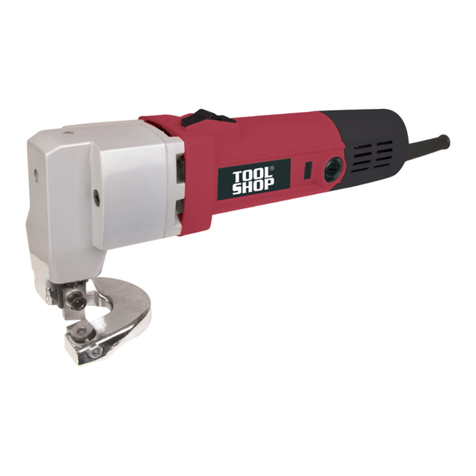
Toolshop
Toolshop 241-9895 User manual
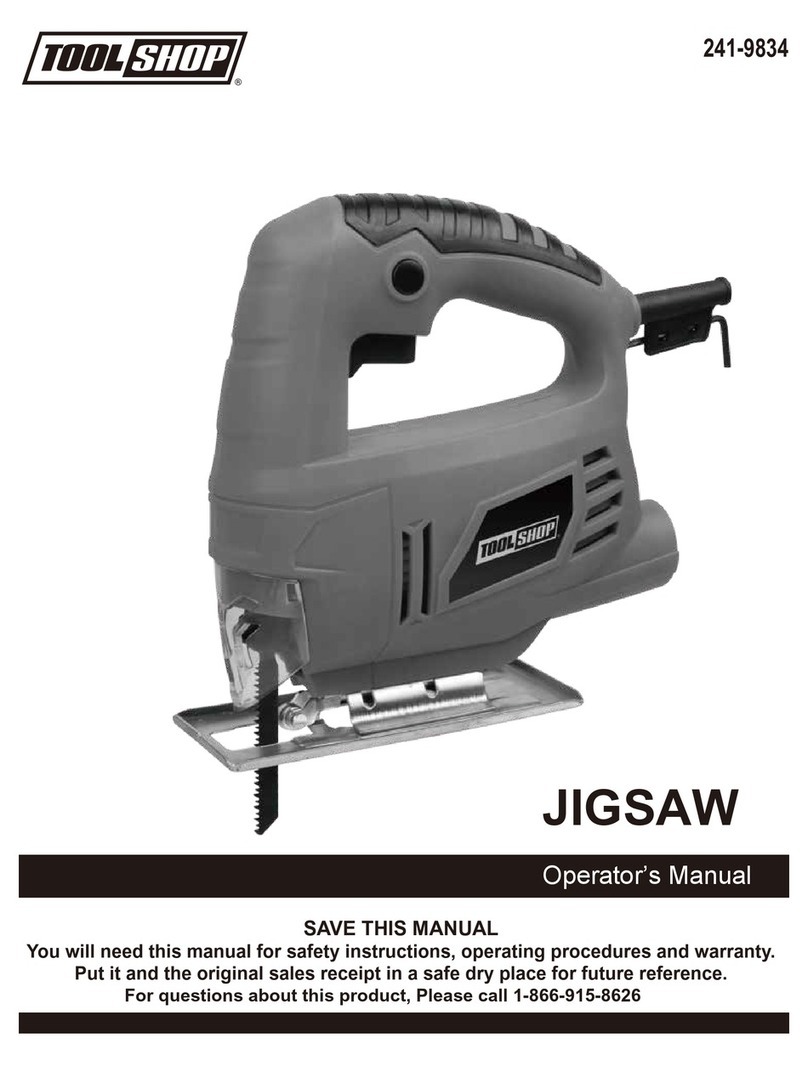
Toolshop
Toolshop 241-9834 User manual

Toolshop
Toolshop 241-9023 User manual

Toolshop
Toolshop 207-4825 User manual

Toolshop
Toolshop 241-9778 User manual
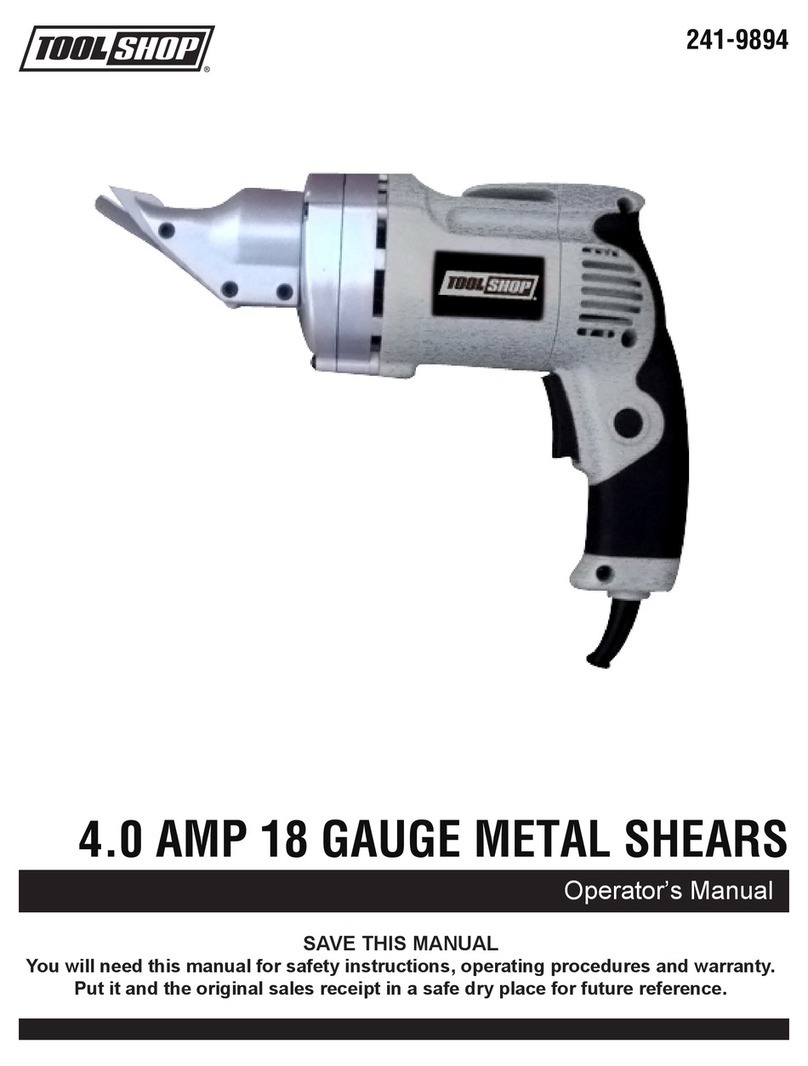
Toolshop
Toolshop 241-9894 User manual

Toolshop
Toolshop 241-9*780 User manual
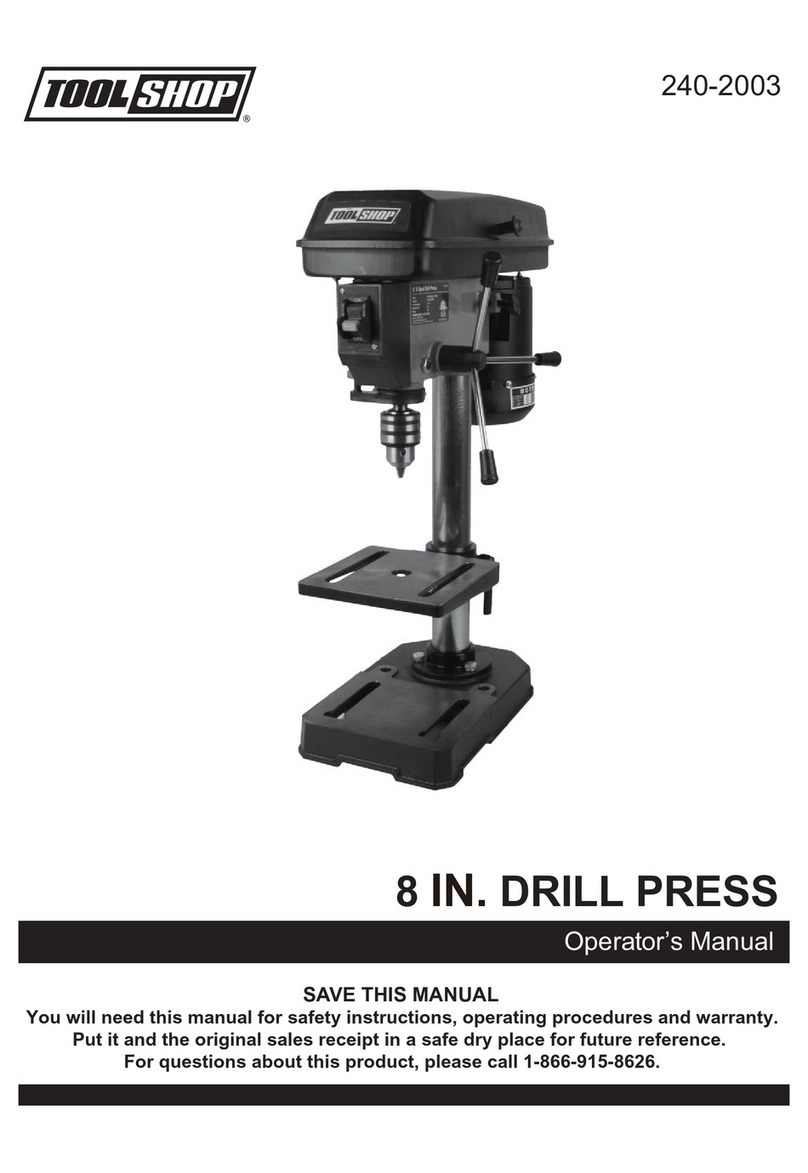
Toolshop
Toolshop 240-2003 User manual

Toolshop
Toolshop 241-8502 User manual
